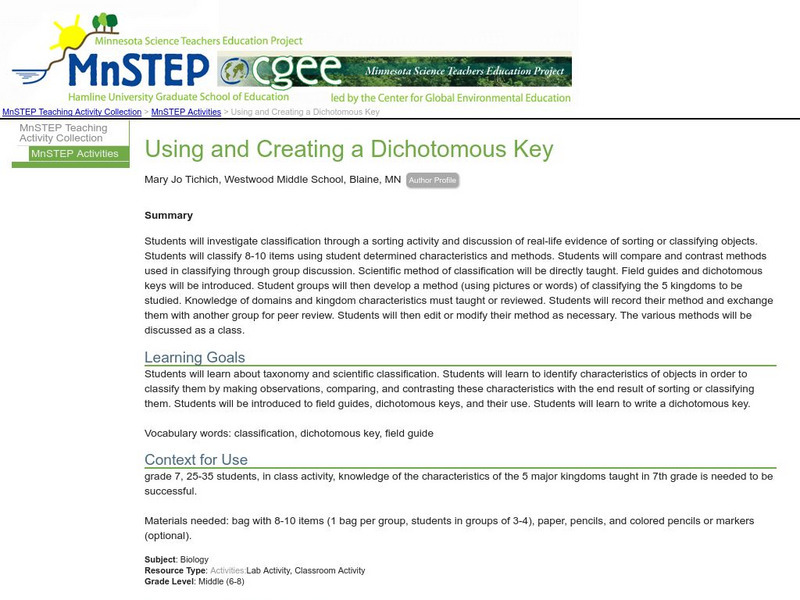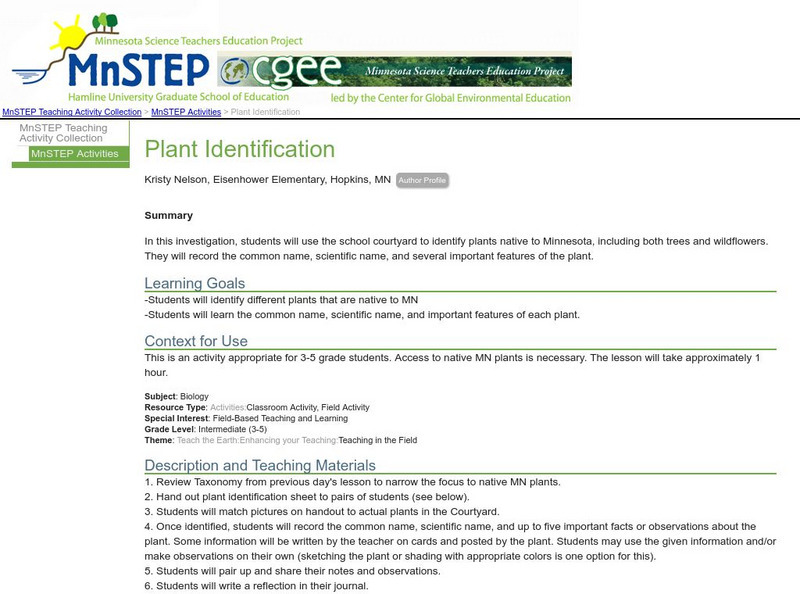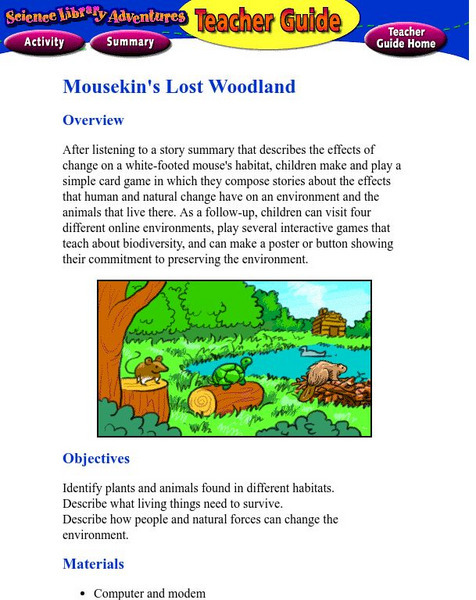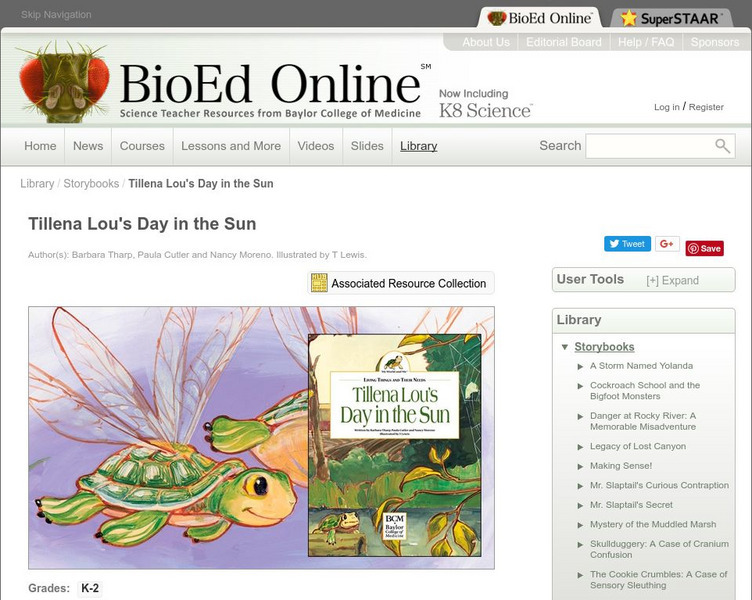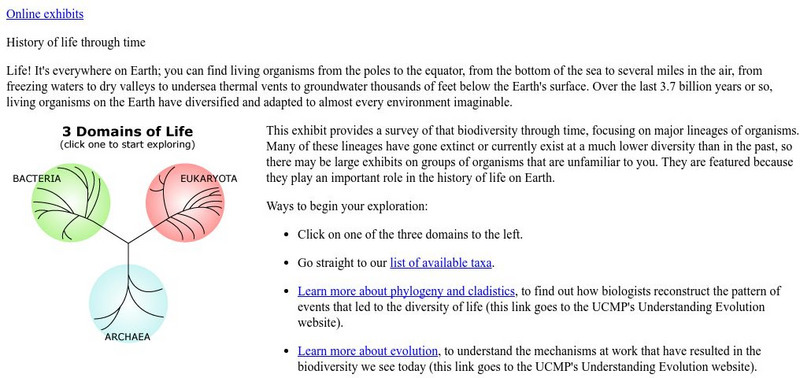Science Education Resource Center at Carleton College
Serc: Using and Creating a Dichotomous Key
Students will investigate classification through a sorting activity and discus real-life evidence of classifying objects.
Science Education Resource Center at Carleton College
Serc: Investigating Insects in Nature
In this lab, students will collect insects while making close observations of living things. They will then classify insects into seven common groups based on characteristics discussed in the classroom.
Science Education Resource Center at Carleton College
Serc: Plant Identification
For this investigation, students will use the school courtyard to identify different plants native to Minnesota, including both trees and wildflowers. They will record the common name, scientific name, and several important features of...
Alabama Learning Exchange
Alex: Introduction to Biology: Organisms
This lesson introduces basic biology principles and the characteristics of living organisms.
Sea World Parks & Entertainment
Sea World: Biodiversity
Depicts biodiversity with a brief narrative. Includes vocabulary, bibliography, and one activity. Subject matter at an upper intermediate grade level or higher.
Education Place
Houghton Mifflin: Eduplace: Mousekin's Lost Woodland
This interactive site has "Mousekin's Lost Woodland" environment game. Play this storytelling game with your friends and learn about different habitats.
Soft Schools
Soft Schools: Classification of Organisms Quiz
Take an interactive quiz over the classification of living things. After completing the quiz, check your score, and then revisit any incorrect question for further review.
Soft Schools
Soft Schools: Classification Quiz
Take this interactive, multiple-choice quiz over classification of organisms, then review your score and any missed questions at the end.
BioEd Online
Bio Ed Online: Tillena Lou's Day in the Sun
Tillena Lou and her siblings spend a lazy day imagining what it might be like if they were other types of animals. What would they need to survive? Synopsis: Tillena Lou explores her home and discovers interesting things about the...
Alabama Learning Exchange
Alex: It's a Small, Small World
As an introduction to the study of diversity of life, science students will use hands-on inquiry experiments to discover the microscopic world through a microscope. Students will use computers to create a brochure or slideshow...
Alabama Learning Exchange
Alex: Wanted Dead or Alive!
In this lesson students will identify the characteristics of living and nonliving things.
Alabama Learning Exchange
Alex: Living Things
During this lesson students will learn about living things. Through this hands-on lesson, students will have the opportunity to create a slideshow presentation and plant poster and explore Internet sites to learn about living things.
Alabama Learning Exchange
Alex: What Is Alive?
This lesson is the opening lesson for a unit of study entitled "Why Doesn't A Caterpillar Grow Up To Be An Oak Tree?" during which students take a look at life cycles of plants and animals. This lesson will encourage students to explore...
Alabama Learning Exchange
Alex: I Know What I Am, but What Are You?
During this lesson students will develop an understanding of how to classify living things and what creates the distinction among them. They will learn to classify living things by effects, environment, and activity.
Utah STEM Foundation
Utah Stem Action Center: Sorting Living Things
Living things live in places that have what they need to survive. Since fish don't breathe air, they need to live in an ocean. That one is pretty obvious, but what about different kinds of trees? Can all animals that breathe air live...
Utah STEM Foundation
Utah Stem Action Center: Backyard Organisms
Utah is a beautiful state with a rich and diverse population of living creatures. This activity challenges you to spend a few minutes outside thinking about and observing the organisms living in your backyard.
Louisiana Department of Education
Louisiana Doe: Louisiana Believes: English Language Arts: Grade K: From Seed to Plant
Students gather information from a variety of texts- literary and informational- to describe the connection between people, events, ideas, and pieces of information. Students are introduced to life cycles by learning about how a plant...
University of California
Ucmp: The Biosphere: Life on Earth
Learn about different forms of life that coexist with us on Earth. This Berkeley article provides links to brief write-ups on the three domains of living organisms: Eukaryota, Bacteria, and Archaea.
Michigan Reach Out
Reach Out Michigan: Being Alive
This site provides a basic lesson plan that classifies objects as alive or not alive. Good for early elementary.
ClassFlow
Class Flow: Plant and Animal Cells
[Free Registration/Login Required] This flipchart is intended to introduce plant and animal cells to fifth graders. Pictures, a web link, and several opportunities for student participation are included. An end-of-lesson assessment is...
ClassFlow
Class Flow: Plants Are Alive
[Free Registration/Login Required] This flipchart accompanies Eric Carle's book, The Tiny Seed.
ClassFlow
Class Flow: Vertebrates
[Free Registration/Login Required] This flipchart is about vertebrate animals. It contains information about the 5 types of vertebrates: fish, amphibians, reptiles, birds, and mammals. The flipchart contains links to websites and...
ClassFlow
Class Flow: Animal Classification
[Free Registration/Login Required] This flipchart introduces the five kingdoms of animal classification. It includes Activote questions to assess understanding of the topic.
ClassFlow
Class Flow: Animal Kingdom
[Free Registration/Login Required] This flipchart introduces students to the animal kingdom, differentiating between vertebrates and invertebrates.


